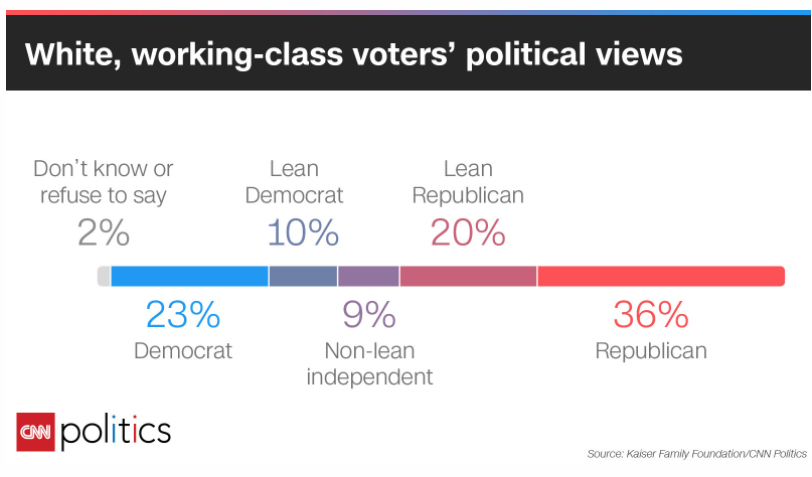Introduction
The CNN Working-Class Whites Poll (conducted between August 9 and September 5, 2016) defined the “working class” as individuals with less than a four-year college degree (Hamel, Sugarman, & Brodie, 2016). The poll included a total of 701 working-class whites; to capture the experiences and thoughts of the white population, researchers included the representatives of other respondents such as Hispanics and blacks that acted as the oversample.
Socio-Economic Status
In contrast to the majority of misconceptions about the group of white working-class Americans; the poll found that the respondents were predominantly happy with their lives and satisfied with their financial situation (Agiesta, 2016). For instance, in answers to the question “Please tell me if each of the following describes how you feel about how things are going in your own life,” 76% of white working-class respondents stated that they were optimistic, and 79% agreed that they were happy, with only 18 respondents saying that they were angry. On the other hand, the white working-class was concerned about the economy of the country. The majority of those interviewed (53%) were very dissatisfied with the economic situation, while 84% said that their views and opinions were not represented well in Washington.
The troubling statistics were also associated with the concerns about the future of the next generation: 50% of respondents indicated that the next generation would have a lower standard of living (Agiesta, 2016). As to the socio-economic characteristics of the American white working class, respondents indicated that it was getting much harder (62%) to get by financially, find good jobs (67%), afford health care (64%), get a good education (48%), own their home (54%), and have a secure retirement (69%) (Hamel et al., 2016). It is important to mention that the income of the white working-class families was under $40,000 (42% of respondents), $40,000-$90,000 (32% of those surveyed), and $90,000+ (17% of respondents) (Hamel et al., 2016). Overall, the group of white working-class voters experiences tremendous challenges regarding their social and economic status, although they are happy about their lives.
Political Preferences
Regarding the political choices, Donald Trump was the most popular among white middle-class respondents: 60% indicated that would vote for Trump; however, as to other groups, for instance, only 3% of black working-class stated that they would consider this candidate (Agiesta, 2016). To illustrate this, Figure 1 below shows the political preferences of the white working-class as found by the CNN poll:

The political views of white working-class voters shifted, although slightly, as in 2012, 59% of white citizens voted for the Republican candidate Mitt Romney. Among people with an income of less than $50,000, 38% voted for Romney, with 52% of individuals with an income of $50 thousand to $90 thousand voting for him as well (Roper Center, 2012). It is also important to mention that the influence of the white working-class on the results of elections is shrinking, as only 41% of voters with income less than $50,000 and 31% of the electorate with an income of $50,000 to $90,000 participated in the 2012 elections (Roper Center, 2012). Although the white working-class had some skepticism about the success of Trump, 50% of non-college graduate primary voters supported Trump compared with 37% of whites with college degrees (Agiesta, 2016).
References
Agiesta, J. (2016). 2016: Last call for working class whites? Web.
Hamel, L., Sugarman, E., & Brodie, M. (2016). Kaiser Family Foundation/CNN working-class whites poll.Web.
Roper Center. (2012). How groups voted in 2012. Web.